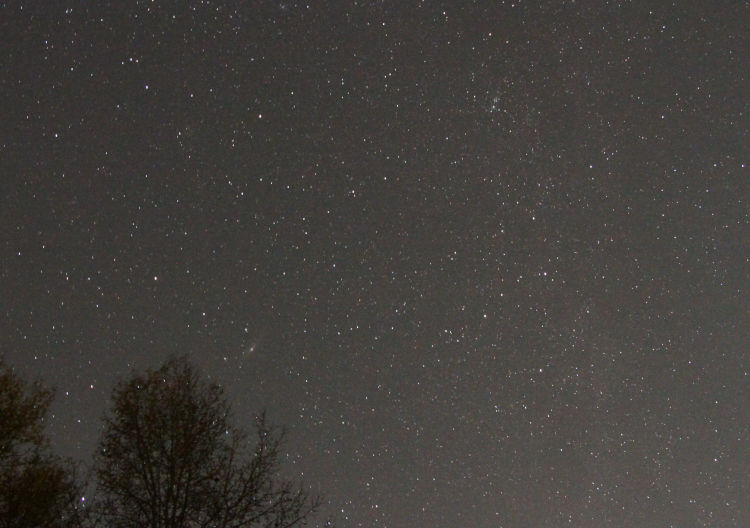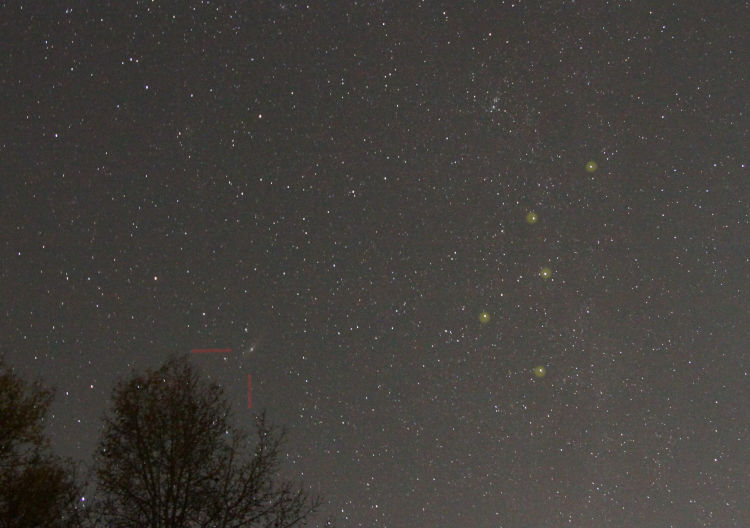I don’t know why I did, because the results were as expected, but I made the attempt again early this morning to capture some meteors. It was, at least, quite clear.

Not a glimmer of shooting star in there anywhere, nor did I see any no matter where I looked. So I boosted ISO to 6400 and just did some night sky exposures of this nature – but this is the funny thing: the narrow dynamic range of any photo means you can only get so bright (white) and no brighter. This means the brightest stars reach maximum exposure quickly, but then the dimmer stars catch up to them in a longer exposure and can end up obscuring the ‘visible’ constellations and asterisms. Cassiopeia, a prominent ‘M’ shaped constellation standing by itself in the sky, has become almost totally obscured in this frame, slightly frustrating because I was specifically framing to get it and the Andromeda galaxy into the frame here. Though the faint Milky Way, which wasn’t visible, shows a little detail along the right half of the frame, so you pick your battles, and I probably could have set an exposure to capture Cassiopeia largely as it appears, but then Andromeda would likely have disappeared – I know I had a hard enough time trying to spot it, and I knew where to look. That was the point of my doing this framing, because the higher ‘peak’ of Cassiopeia points to Andromeda, more or less. Here’s a marked version:

The five most prominent stars of Cassiopeia are marked in yellow, while Andromeda is found within the red pointers. This is shot a little wider than a ‘normal’ view, which would have placed them right at the very edges of the frame, but basically, find Cassiopeia and you know how to locate Andromeda, though it may take binoculars and it will still be very faint.
I did make an attempt at Andromeda with the 600mm lens, but my focus was slightly off. Moreover, really nice definition would take an exposure of significant length (or a much faster lens at least, but that would probably not be sufficient by itself,) and in that time, the Earth turns, the sky moves, and Andromeda blurs sideways – it really requires a tracking motor to stay on target. One of these days.
I also played with Orion and his dog, briefly.

I was trying to balance framing to get Sirius into the picture, as well as capturing a little of the Orion nebula, while not getting too much motion blur into the frame – this is as close as I got. Now we’re a bit closer than ‘normal,’ but Sirius, the Dog Star and the brightest star in the sky, is there at lower left while the bottom half of Orion is at upper right – the key stars are still prominent, but you can see how many dimmer stars surrounding them have appeared in the longer exposure now. And yes, there’s a hint of the Orion nebula forming a faint haze around the ‘dagger’ stars, though really, the entire region is rife with reflecting dust and gases that it takes a lot more effort to capture in an image, or even see. Just so you know, this is a nine-second exposure at ISO 6400, f5.6, and 42mm focal length, and I did perform my sensor-noise removal trick afterward. This seems a little complicated at first, but once you’ve done it a couple of times, it takes less than a minute to accomplish and helps a lot.
One more, for giggles.

I said above that Sirius is the brightest star in the sky, which is true, but some of the planets can exceed that easily – that’s Jupiter at upper right. While it looks like cloud cover down on the horizon, I’m fairly certain it’s just atmospheric humidity, catching the light from distant Sanford, NC (I think.) My view east and northeast was also stained, but by Durham’s light instead – this isn’t a good area to escape light pollution, but the best I have within easy reach. And that streak left of center is not a meteor, but a mere airplane instead – they were exceedingly hard to avoid, and I don’t think I’d spotted this one until it got a little closer.
But yeah, that was it – not really worth the trip.



















































